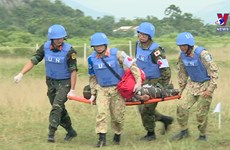Cold brings rise in flu, rubella in Hanoi
Rubella had been on the rise in Hanoi over the past two months,
according to Nguyen Hong Ha, Deputy Director of the Hanoi Hospital
for Tropical Diseases.
Rubella had been on the rise in Hanoi over the past two months,
according to Nguyen Hong Ha, Deputy Director of the Hanoi Hospital
for Tropical Diseases.
The number of patients who received treatment for rubella during the recent Tet (Lunar New Year) was higher than in previous years, Ha said.
Cold and abnormal weather conditions were one of the reasons for the problem, he added.
Over 120 cases of flu and rubella were recorded by the hospital in the past 10 days.
Some patients who showed symptoms of encephalitis were treated in the hospital, said Ha.
However, the exact number of cases was still unknown as some sufferers treated themselves at home, he said.
The public has been advised of the symptoms of both rubella and measles.
Measles normally carries a high fever, runny nose, sore throat and a cough. Two or three days later a bright red, blotchy rash breaks out on the face and neck. Within a few days the rash spreads to the body, arms and legs, by which time the rash will begin to fade from the face.
Occasionally, measles can lead to complications including pneumonia. However, only one child in a 1,000 with measles will go on to develop encephalitis or meningitis.
Rubella, more commonly known as German measles, may begin with a 1-2 day fever. A rash begins on the face and spreads down the body but rubella does not leave bruises like measles.
There is no specific treatment for rubella and unless there are complications, it should resolve itself. Patients should eat healthily, rest and remain isolated until the rash disappears.
There is a safe and effective vaccine to prevent rubella, recommended for everyone, according to Ha./.
The number of patients who received treatment for rubella during the recent Tet (Lunar New Year) was higher than in previous years, Ha said.
Cold and abnormal weather conditions were one of the reasons for the problem, he added.
Over 120 cases of flu and rubella were recorded by the hospital in the past 10 days.
Some patients who showed symptoms of encephalitis were treated in the hospital, said Ha.
However, the exact number of cases was still unknown as some sufferers treated themselves at home, he said.
The public has been advised of the symptoms of both rubella and measles.
Measles normally carries a high fever, runny nose, sore throat and a cough. Two or three days later a bright red, blotchy rash breaks out on the face and neck. Within a few days the rash spreads to the body, arms and legs, by which time the rash will begin to fade from the face.
Occasionally, measles can lead to complications including pneumonia. However, only one child in a 1,000 with measles will go on to develop encephalitis or meningitis.
Rubella, more commonly known as German measles, may begin with a 1-2 day fever. A rash begins on the face and spreads down the body but rubella does not leave bruises like measles.
There is no specific treatment for rubella and unless there are complications, it should resolve itself. Patients should eat healthily, rest and remain isolated until the rash disappears.
There is a safe and effective vaccine to prevent rubella, recommended for everyone, according to Ha./.













